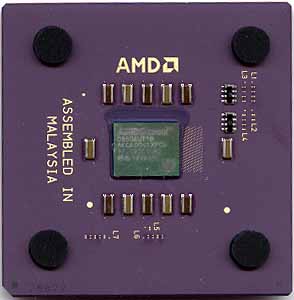AMD Duron 850: Getting ready for the battle
by Anand Lal Shimpi on January 8, 2001 1:50 AM EST- Posted in
- CPUs
The Chip
The Duron 850 remains unchanged from the past five Duron processor releases that we have seen. The Socket-A processor is still given the benefit of the Athlon's 100MHz DDR EV6 FSB that offers bandwidth equivalent to that of a 200MHz bus.

Combining a high bandwidth FSB that keeps the processor fed healthily with a very large L1 data cache (64KB data/64KB instruction) and a sizeable L2 cache (64KB), the Duron offers approximately 90% of the performance of the Athlon in most cases.
Currently all Durons are manufactured in AMD's Fab25 plant in Austin, Texas, using aluminum interconnects. While the old trick of simply looking at the polishing used on the processor's die used to tell us whether an AMD CPU was produced at Fab25 or Fab30 in Dresden, variations in the polishing dyes have degraded the usefulness of that method. The one thing to keep in mind though is that currently no Durons, regardless of the shade of the polishing dye used on the processor, are manufactured using copper interconnects. The first Durons to come out of Fab30 in Dresden may end up being the upcoming parts based on the Morgan core, however depending on how quickly AMD needs to ramp the clock speed of the Duron this may not hold true.
For more information on the Duron's architecture, be sure to read our original review of AMD's Duron processor.
In comparison to the Celeron, we have illustrated time and time again that the Duron is the faster solution on a clock for clock basis. When combined with a UMA (unified memory architecture) platform (e.g. SiS 730S, VIA KM133) the Duron's performance lead over the Celeron is cut significantly. A major reason behind this is that the Celeron's most popular UMA platform is the i810E, which is definitely much more mature than both of the Duron's UMA platforms.
We have already compared the Duron to the Celeron on their respective UMA platforms; for a clock for clock comparison read our Celeron 800 Review.
As an overclocker, the Duron 850 is no better and no worse than the Duron 800. We have seen reports around the web of users hitting up to 1.2GHz with their Duron 800s, however the 950MHz - 1.1GHz range is more realistic for the average overclock with a processor like the Duron 850.
Duron 850 Specifications
· 25 million transistor 0.18-micron Duron core with Aluminum interconnects
· 850MHz clock speed - 8.5x clock multiplier
· 128KB on-die L1 cache running at core speed
· 64-bit exclusive 64KB on-die L2 cache running at clock speed
· 462-pin Socket A EV6 CPU interface running at 100MHz DDR (effectively 200MHz)
· 1.60v core voltage
|
CPU
Specification Comparison
|
||||||||
| AMD Duron |
AMD
Athlon
|
Intel
Pentium III
|
Intel
Celeron
|
|||||
| Core |
Spitfire
|
K7
|
K75
|
Thunderbird
|
Katmai
|
Coppermine
|
Mendocino
|
Coppermine128
|
|
Clock Speed |
600
- 850 MHz
|
500
- 700 MHz
|
750
- 1000 MHz
|
750
- 1200 MHz
|
450
- 600 MHz
|
500
- 1000 MHz
|
300
- 533 MHz
|
533
- 800MHz
|
| L1 Cache |
128KB
|
32KB
|
||||||
| L2 Cache |
64KB
|
512KB
|
256KB
|
512KB
|
256KB
|
128KB
|
||
| L2 Cache speed |
core
clock
|
1/2
core
|
2/5
or 1/3 core
|
core
clock
|
1/2
core
|
core
clock
|
||
| L2 Cache bus |
64-bit
|
256-bit
|
64-bit
|
256-bit
|
||||
| System Bus |
100 MHz DDR (200 MHz effective) EV6
|
100
- 133 MHz GTL+
|
66/100
MHz GTL+
|
|||||
| Interface |
Socket-A
|
Slot-A
|
Socket-A
Slot-A (OEM only up to 800MHz) |
Slot-1
|
Slot-1
Socket-370 |
Socket-370
|
||
| Manufacturing Process |
0.18
micron
|
0.25
micron
|
0.18
micron
|
0.25
micron
|
0.18
micron
|
0.25
micron
|
0.18
micron
|
|
| Die Size |
100mm^2
|
184
mm^2
|
102mm^2
|
120mm^2
|
128mm^2
|
106mm^2
|
153mm^2
|
106mm^2
|
| Transistor Count |
25
million
|
22
million
|
37
million
|
9.5
million
|
28
million
|
19
million
|
28
million
|
|










0 Comments
View All Comments